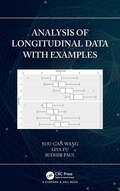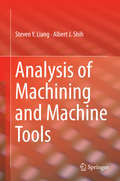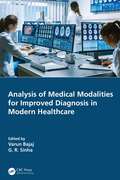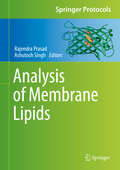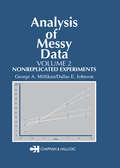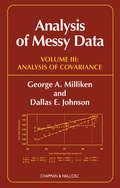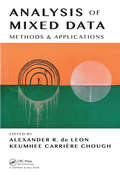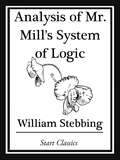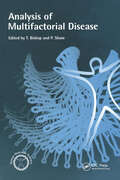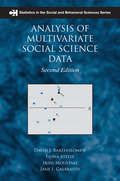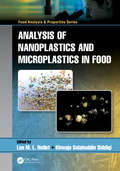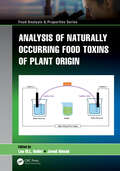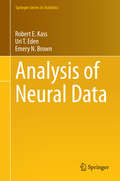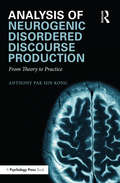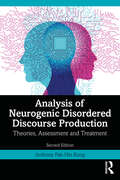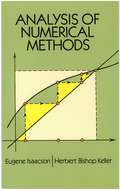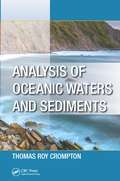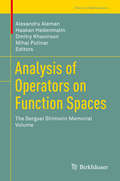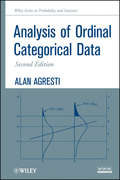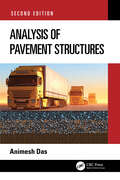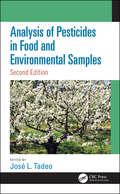- Table View
- List View
Analysis of Longitudinal Data with Example
by Sudhir Paul You-Gan Wang Liya FuDevelopment in methodology on longitudinal data is fast. Currently, there are a lack of intermediate /advanced level textbooks which introduce students and practicing statisticians to the updated methods on correlated data inference. This book will present a discussion of the modern approaches to inference, including the links between the theories of estimators and various types of efficient statistical models including likelihood-based approaches. The theory will be supported with practical examples of R-codes and R-packages applied to interesting case-studies from a number of different areas. Key Features: •Includes the most up-to-date methods •Use simple examples to demonstrate complex methods •Uses real data from a number of areas •Examples utilize R code
Analysis of Machining and Machine Tools
by Steven Y. Liang Albert J. ShihThis book provides readers with the fundamental, analytical, and quantitative knowledge of machining process planning and optimization based on advanced and practical understanding of machinery, mechanics, accuracy, dynamics, monitoring techniques, and control strategies that they need to understanding machining and machine tools. It is written for first-year graduate students in mechanical engineering, and is also appropriate for use as a reference book by practicing engineers. It covers topics such as single and multiple point cutting processes; grinding processes; machine tool components, accuracy, and metrology; shear stress in cutting, cutting temperature and thermal analysis, and machine tool chatter. The second section of the book is devoted to "Non-Traditional Machining," where readers can find chapters on electrical discharge machining, electrochemical machining, laser and electron beam machining, and biomedical machining. Examples of realistic problems that engineers are likely to face in the field are included, along with solutions and explanations that foster a didactic learning experience.
Analysis of Medical Modalities for Improved Diagnosis in Modern Healthcare
by G. R. Sinha Varun BajajandIn modern healthcare, various medical modalities play an important role in improving the diagnostic performance in healthcare systems for various applications, such as prosthesis design, surgical implant design, diagnosis and prognosis, and detection of abnormalities in the treatment of various diseases. Analysis of Medical Modalities for Improved Diagnosis in Modern Healthcare discusses the uses of analysis, modeling, and manipulation of modalities, such as EEG, ECG, EMG, PCG, EOG, MRI, and FMRI, for an automatic identification, classification, and diagnosis of different types of disorders and physiological states. The analysis and applications for post-processing and diagnosis are much-needed topics for researchers and faculty members all across the world in the field of automated and efficient diagnosis using medical modalities. To meet this need, this book emphasizes real-time challenges in medical modalities for a variety of applications for analysis, classification, identification, and diagnostic processes of healthcare systems. Each chapter starts with the introduction, need and motivation of the medical modality, and a number of applications for the identification and improvement of healthcare systems. The chapters can be read independently or consecutively by research scholars, graduate students, faculty members, and practicing scientists who wish to explore various disciplines of healthcare systems, such as computer sciences, medical sciences, and biomedical engineering. This book aims to improve the direction of future research and strengthen research efforts of healthcare systems through analysis of behavior, concepts, principles, and case studies. This book also aims to overcome the gap between usage of medical modalities and healthcare systems. Several novel applications of medical modalities have been unlocked in recent years, therefore new applications, challenges, and solutions for healthcare systems are the focus of this book.
Analysis of Membrane Lipids (Springer Protocols Handbooks)
by Rajendra Prasad Ashutosh SinghThis book provides a timely overview of analytical tools and methodological approaches for studying membrane lipids. It outlines the ground-breaking advances that have been made over the last two decades in high-throughput lipidomics, and in studying lipid-protein interactions, signalling pathways and the regulation of lipid metabolism.This user-friendly laboratory handbook is an ideal companion for membrane biologists, researchers, students, and clinicians alike. It is also well suited for teaching biochemistry, microbiology and biotechnology courses, making it a must-have for everyone whose work involves lipid research.
Analysis of Messy Data Volume 1: Designed Experiments, Second Edition
by George A. Milliken Dallas E. JohnsonA bestseller for nearly 25 years, Analysis of Messy Data, Volume 1: Designed Experiments helps applied statisticians and researchers analyze the kinds of data sets encountered in the real world. Written by two long-time researchers and professors, this second edition has been fully updated to reflect the many developments that have occurred since t
Analysis of Messy Data, Volume II: Nonreplicated Experiments
by Dallas E. Johnson George A. MillikenResearchers often do not analyze nonreplicated experiments statistically because they are unfamiliar with existing statistical methods that may be applicable. Analysis of Messy Data, Volume II details the statistical methods appropriate for nonreplicated experiments and explores ways to use statistical software to make the required computations feasible.
Analysis of Messy Data, Volume III: Analysis of Covariance
by George A. Milliken Dallas E. JohnsonAnalysis of covariance is a very useful but often misunderstood methodology for analyzing data where important characteristics of the experimental units are measured but not included as factors in the design. Analysis of Messy Data, Volume 3: Analysis of Covariance takes the unique approach of treating the analysis of covariance problem by looking
Analysis of Mixed Data: Methods & Applications
by ALEXANDER R. de LEON Keumhee Carrière ChoughA comprehensive source on mixed data analysis, Analysis of Mixed Data: Methods & Applications summarizes the fundamental developments in the field. Case studies are used extensively throughout the book to illustrate interesting applications from economics, medicine and health, marketing, and genetics. Carefully edited for smooth readability and
Analysis of Mr. Mill's System of Logic
by William StebbingPhilosophical text written by William Stebbing, author of "Five Centuries of English Verse" and "Sir Walter Ralegh A Biography"
Analysis of Multifactorial Diseases
by T. Bishop P. ShamAnalysis of Multifactorial Diseases examines the evidence of genetic factors that increase susceptibility to a range of complex diseases and describes the approaches taken to identify these genes. It reviews the successes and failures and examines whether there are any general conclusions to be drawn from this current range of approaches.
Analysis of Multivariate Social Science Data (Chapman & Hall/CRC Statistics in the Social and Behavioral Sciences)
by Irini Moustaki David J. Bartholomew Fiona SteeleDrawing on the authors' varied experiences working and teaching in the field, Analysis of Multivariate Social Science Data, Second Editionenables a basic understanding of how to use key multivariate methods in the social sciences. With updates in every chapter, this edition expands its topics to include regression analysis, con
Analysis of Multivariate and High-Dimensional Data
by Inge Koch'Big data' poses challenges that require both classical multivariate methods and contemporary techniques from machine learning and engineering. This modern text equips you for the new world - integrating the old and the new, fusing theory and practice and bridging the gap to statistical learning. The theoretical framework includes formal statements that set out clearly the guaranteed 'safe operating zone' for the methods and allow you to assess whether data is in the zone, or near enough. Extensive examples showcase the strengths and limitations of different methods with small classical data, data from medicine, biology, marketing and finance, high-dimensional data from bioinformatics, functional data from proteomics, and simulated data. High-dimension low-sample-size data gets special attention. Several data sets are revisited repeatedly to allow comparison of methods. Generous use of colour, algorithms, Matlab code, and problem sets complete the package. Suitable for master's/graduate students in statistics and researchers in data-rich disciplines.
Analysis of Nanoplastics and Microplastics in Food (Food Analysis & Properties)
by Leo M. L. Nollet and Khwaja Salahuddin SiddiqiThe world’s ever increasing use of plastics has created large areas of floating plastic waste in the oceans—so-called plastic soup. This floating plastic debris is gradually fragmenting into smaller particles which eventually become microplastics, and even nanoplastics. Analysis of Nanoplastics and Microplastics in Food compiles data on nanoplastics and microplastics in food. To date, there is some data on this, particularly for the marine environment. Fish show high concentrations, but because microplastics are mostly present in the stomach and intestines, they are usually removed and consumers are not exposed. But in crustaceans and bivalve molluscs like oysters and mussels, the digestive tract is consumed, so there is some exposure. Microplastics have also been reported in honey, beer, and table salt. Key Features: Discusses sampling and analysis of nano- and microplastics Details the impacts of plastic residues in diverse compartments of the environment Includes a discussion of microplastics in freshwater Discusses interactions of microplastics and POPs This book brings to light the reality—and dangers—of microplastics in food. Pollutants like polychlorinated biphenyls (PCBs) and polycyclic aromatic hydrocarbons (PAHs) can accumulate in microplastics. Some studies suggest that, after consuming microplastics in food, these substances may transfer into tissues. So, it is important to estimate the average intake. Since engineered nanoparticles (from different types of nanomaterials) can enter human cells, this reality can pose consequences for human health. Also available in the Food Analysis and Properties Series: Mass Spectrometry Imaging in Food Analysis, edited by Leo M. L. Nollet (ISBN: 978-1-138-37069-2) Proteomics for Food Authentication, edited by Leo M. L. Nollet and Semih Ӧtleş (ISBN: 978-0-367-20505-8) Food Aroma Evolution: During Food Processing, Cooking, and Aging, edited by Matteo Bordiga and Leo M. L. Nollet (ISBN: 978-1-138-33824-1) For a complete list of books in this series, please visit our website at: www.crcpress.com/Food-Analysis--Properties/book-series/CRCFOODANPRO
Analysis of Naturally Occurring Food Toxins of Plant Origin (Food Analysis & Properties)
by Javed Ahmad Nollet, Leo M. L.Natural toxins are toxic compounds that are naturally produced by living organisms. These toxins are not harmful to the organisms themselves, but they may be toxic to other creatures, including humans, when eaten. These chemical compounds have diverse structures and differ in biological function and toxicity. Some toxins are produced by plants as a natural defense mechanism against predators, insects, or microorganisms, or as a consequence of infestation with microorganisms, such as mold, in response to climate stress (such as drought or extreme humidity). Well-known groups of natural toxins of plant origin are: cyanogenic glycosides, pyrrolizidine alkaloids, furocoumarins, lectins, and glycoalkaloids. These plant-origin natural toxins can cause a variety of adverse health effects and pose a serious health threat to both humans and livestock. Analysis of Naturally Occurring Food Toxins of Plant Origin is divided into three sections that provide a detailed overview of different classes of food toxins that are naturally found in plants, including various analytical techniques used for their structural characterization, identification, detection, and quantification. This book provides in-depth information and comprehensive discussion over quantitative and qualitative analysis of natural toxins in plant-based foods. Key Features: • Provides a detailed overview of different classes of natural toxins found in plants. • Explains how IR, NMR, and mass spectrometry are utilized in characterization and identification. • Describes applicability of HPLC, LC-MS, GC-MS, and HPTLC techniques for detection and quantification. • Discusses progress in the field related to capillary electrophoresis, ELISA, and biosensors for quantitative application of these techniques. Also available in the Food Analysis and Properties Series: Nutriomics: Well-being through Nutrition, edited by Devarajan Thangadurai,Saher Islam,Leo M.L. Nollet, Juliana Bunmi Adetunji (ISBN: 9780367695415) Bioactive Peptides from Food: Sources, Analysis, and Functions, edited by Leo M.L. Nollet and Semih Ötleş (ISBN: 9780367608538) Mass Spectrometry in Food Analysis, edited by Leo M.L. Nollet, and Robert Winkler (ISBN: 9780367548797) For a complete list of books in this series, please visit our website at:www.crcpress.com/Food-Analysis--Properties/book-series/CRCFOODANPRO
Analysis of Neural Data (Springer Series in Statistics)
by Robert E. Kass Uri T. Eden Emery N. BrownContinual improvements in data collection and processing have had a huge impact on brain research, producing data sets that are often large and complicated. By emphasizing a few fundamental principles, and a handful of ubiquitous techniques, Analysis of Neural Data provides a unified treatment of analytical methods that have become essential for contemporary researchers. Throughout the book ideas are illustrated with more than 100 examples drawn from the literature, ranging from electrophysiology, to neuroimaging, to behavior. By demonstrating the commonality among various statistical approaches the authors provide the crucial tools for gaining knowledge from diverse types of data. Aimed at experimentalists with only high-school level mathematics, as well as computationally-oriented neuroscientists who have limited familiarity with statistics, Analysis of Neural Data serves as both a self-contained introduction and a reference work.
Analysis of Neurogenic Disordered Discourse Production: From Theory to Practice
by Anthony Pak KongAnalysis of Neurogenic Disordered Discourse Production provides a comprehensive review and discussion of aphasia and its related disorders, their corresponding clinical discourse symptoms that speech-language pathologists and related healthcare professionals should address, and the different methods of discourse elicitation that are research- and clinically-oriented. Contemporary issues related to disordered/clinical discourse production are covered, and discussions of various treatment options in relation to discourse symptoms are included. Finally, the manifestation of discourse symptoms as a function of speakers’ bilingual/multilingual status and specific considerations related to clinical assessment and intervention are explored. Readers who want to learn the background and techniques of discourse analysis, refresh their knowledge of discourse production, update their knowledge of assessment and treatment of discourse production, and learn about contemporary issues of discourse annotation and analysis using existing computer software will find this book a valuable tool. With its comprehensive coverage, it offers a thorough understanding of the nature, assessment, and remediation of discourse deficits in aphasia and related disorders. Readers will also benefit from examples throughout the book that connect theory to real-life contexts of discourse production.
Analysis of Neurogenic Disordered Discourse Production: Theories, Assessment and Treatment
by Anthony Pak-Hin KongAnalysis of discourse production among speakers with acquired communication disorders is an important and necessary clinical procedure. This book provides a comprehensive review and discussion of aphasia and its related disorders, their corresponding clinical discourse symptoms that speech-and-language pathologists should address, and the different methods of discourse elicitation that are clinically and research oriented. This edition has been thoroughly updated throughout to include the latest research, including advances in word retrieval and discourse production, cognitive and multicultural aspects of disordered discourse production, application of technology to understand and evaluate spoken discourse, and evidence-based intervention of discourse impairments. Contemporary issues related to disordered/clinical discourse elicitation are added. Recent advancement in discourse analysis is covered and discussions of various treatment options of discourse symptoms are provided. Finally, the manifestation of discourse symptoms as a function of speakers’ multilingual/multi-cultural status and specific considerations related to clinical assessment and remediation are explored. As the only introductory text to include comprehensive coverage of basic knowledge of neurogenic disordered discourse, it is a must-read for students, clinicians, and researchers in various fields. Readers will also benefit from plenty of examples that provide a connection between the theoretical contents presented in the text and application to real-life contexts of discourse production.
Analysis of Numerical Methods (Dover Books on Mathematics)
by Herbert Bishop Keller Eugene IsaacsonIn this age of omnipresent digital computers and their capacity for implementing numerical methods, no applied mathematician, physical scientist, or engineer can be considered properly trained without some understanding of those methods. This text, suitable for advanced undergraduate and graduate-level courses, supplies the required knowledge — not just by listing and describing methods, but by analyzing them carefully and stressing techniques for developing new methods.Based on each author's more than 40 years of experience in teaching university courses, this book offers lucid, carefully presented coverage of norms, numerical solution of linear systems and matrix factoring, iterative solutions of nonlinear equations, eigenvalues and eigenvectors, polynomial approximation, numerical solution of differential equations, and more. No mathematical preparation beyond advanced calculus and elementary linear algebra (or matrix theory) is assumed. Examples and problems are given that extend or amplify the analysis in many cases.
Analysis of Oceanic Waters and Sediments
by Thomas Roy CromptonThe presence of concentrations of organic substances and cations in seawater is a matter of increasing concern to the water industry, environmentalists and the general public alike. It poses a threat of possible health hazards for humans, fish and crustacea. Until fairly recently, the analysis of seawater was limited to a number of major constituen
Analysis of Operators on Function Spaces: The Serguei Shimorin Memorial Volume (Trends in Mathematics)
by Mihai Putinar Alexandru Aleman Haakan Hedenmalm Dmitry KhavinsonThis book contains both expository articles and original research in the areas of function theory and operator theory. The contributions include extended versions of some of the lectures by invited speakers at the conference in honor of the memory of Serguei Shimorin at the Mittag-Leffler Institute in the summer of 2018. The book is intended for all researchers in the fields of function theory, operator theory and complex analysis in one or several variables. The expository articles reflecting the current status of several well-established and very dynamical areas of research will be accessible and useful to advanced graduate students and young researchers in pure and applied mathematics, and also to engineers and physicists using complex analysis methods in their investigations.
Analysis of Ordinal Categorical Data (Wiley Series in Probability and Statistics #656)
by Alan AgrestiStatistical science’s first coordinated manual of methods for analyzing ordered categorical data, now fully revised and updated, continues to present applications and case studies in fields as diverse as sociology, public health, ecology, marketing, and pharmacy. Analysis of Ordinal Categorical Data, Second Edition provides an introduction to basic descriptive and inferential methods for categorical data, giving thorough coverage of new developments and recent methods. Special emphasis is placed on interpretation and application of methods including an integrated comparison of the available strategies for analyzing ordinal data. Practitioners of statistics in government, industry (particularly pharmaceutical), and academia will want this new edition.
Analysis of Panel Data
by Cheng HsiaoThis book provides a comprehensive, coherent, and intuitive review of panel data methodologies that are useful for empirical analysis. Substantially revised from the second edition, it includes two new chapters on modeling cross-sectionally dependent data and dynamic systems of equations. Some of the more complicated concepts have been further streamlined. Other new material includes correlated random coefficient models, pseudo-panels, duration and count data models, quantile analysis, and alternative approaches for controlling the impact of unobserved heterogeneity in nonlinear panel data models.
Analysis of Panel Data (Econometric Society Monographs #Series Number 34)
by Cheng HsiaoNow in its fourth edition, this comprehensive introduction of fundamental panel data methodologies provides insights on what is most essential in panel literature. A capstone to the forty-year career of a pioneer of panel data analysis, this new edition's primary contribution will be the coverage of advancements in panel data analysis, a statistical method widely used to analyze two or higher-dimensional panel data. The topics discussed in early editions have been reorganized and streamlined to comprehensively introduce panel econometric methodologies useful for identifying causal relationships among variables, supported by interdisciplinary examples and case studies. This book, to be featured in Cambridge's Econometric Society Monographs series, has been the leader in the field since the first edition. It is essential reading for researchers, practitioners and graduate students interested in the analysis of microeconomic behavior.
Analysis of Pavement Structures
by Animesh DasAnalysis of Pavement Structures brings together current research and existing knowledge on the analysis and design of pavements and introduces load and thermal stress analyses of asphalt and concrete pavement structures in a simple and step-by-step manner. For the second edition of this book, a new chapter on numerical implementation (using FEM) of pavement analysis is added along with topics such as mechanical modeling of granular materials, applications of convolution theorems in visco-elasticity, visco-elastic Poisson’s ratio, concepts of fracture mechanics in relation to fatigue of asphalt mix, solution of semi-infinite and so forth. New solved examples and schematic diagrams are also added. Features: Presents a simple, step-by-step approach for pavement analysis including systematic compilation of research work in the area Discusses further elaborations in terms of extended analytical formulations on some selected topics Includes new chapter on finite element analysis for pavement structures Contains more solved examples to understand the concepts better Explores primary application of pavement analysis in pavement thickness design This book is aimed at graduate students, structural mechanics researchers, and senior undergraduate students in civil/pavement/highway/transport engineering.
Analysis of Pesticides in Food and Environmental Samples, Second Edition
by Jose L. TadeoThis book provides a critical overview of analytical methods used for the determination of pesticide residues and other contaminants in food and environmental samples by modern instrumental analysis. It contains up-to-date material including recent trends in sample preparation, general methods used for pesticide analysis and quality assurance aspects, and chromatographic and immunoassay methods. The rest of the book describes particular analytical methods used for the determination of pesticides in food and soil, water and air. In addition, the levels of these chemicals found in food, their regulatory aspects and the monitoring of pesticides in the environment are described.
